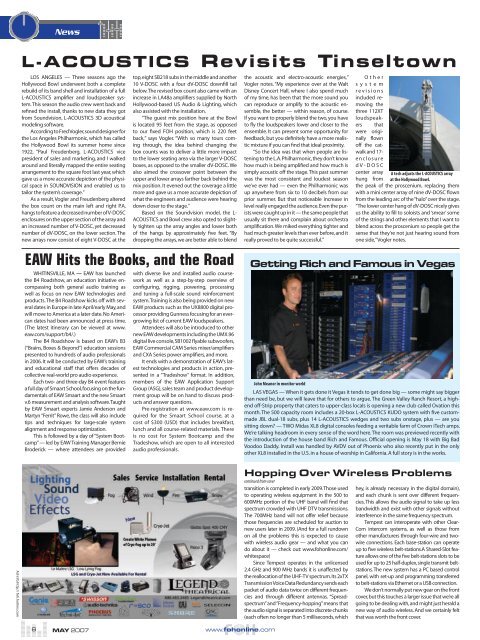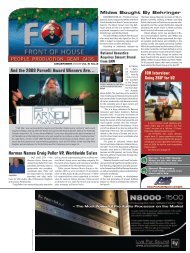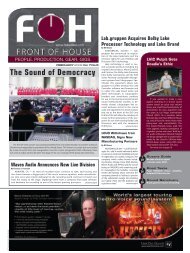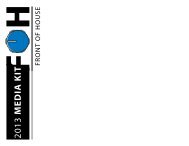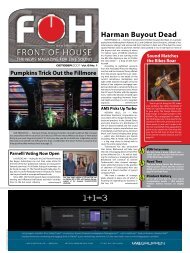May Issue - FOH Online
May Issue - FOH Online
May Issue - FOH Online
Create successful ePaper yourself
Turn your PDF publications into a flip-book with our unique Google optimized e-Paper software.
Ad info:http:// foh.hotims.com<br />
News<br />
L-ACOUSTICS Revisits Tinseltown<br />
LOS ANGELES — Three seasons ago the<br />
Hollywood Bowl underwent both a complete<br />
rebuild of its band shell and installation of a full<br />
L-ACOUSTICS amplifier and loudspeaker system.<br />
This season the audio crew went back and<br />
refined the install, thanks to new data they got<br />
from Soundvision, L-ACOUSTICS 3D acoustical<br />
modeling software.<br />
According to Fred Vogler, sound designer for<br />
the Los Angeles Philharmonic, which has called<br />
the Hollywood Bowl its summer home since<br />
1922, “Paul Freudenberg, L-ACOUSTICS vice<br />
president of sales and marketing, and I walked<br />
around and literally mapped the entire seating<br />
arrangement to the square foot last year, which<br />
gave us a more accurate depiction of the physical<br />
space in SOUNDVISION and enabled us to<br />
tailor the system’s coverage.”<br />
As a result, Vogler and Freudenberg altered<br />
the box count on the main left and right P.A.<br />
hangs to feature a decreased number of V-DOSC<br />
enclosures on the upper section of the array and<br />
an increased number of V-DOSC, yet decreased<br />
number of dV-DOSC, on the lower section. The<br />
new arrays now consist of eight V-DOSC at the<br />
EAW Hits the Books, and the Road<br />
WHITINSVILLE, MA — EAW has launched<br />
the B4 Roadshow, an education initiative encompassing<br />
both general audio training as<br />
well as focus on new EAW technologies and<br />
products. The B4 Roadshow kicks off with several<br />
dates in Europe in late April/early <strong>May</strong>, and<br />
will move to America at a later date. No American<br />
dates had been announced at press time.<br />
(The latest itinerary can be viewed at www.<br />
eaw.com/support/b4/.)<br />
The B4 Roadshow is based on EAW’s B3<br />
(“Brains, Boxes & Beyond”) education sessions<br />
presented to hundreds of audio professionals<br />
in 2006. It will be conducted by EAW’s training<br />
and educational staff that offers decades of<br />
collective real-world pro audio experience.<br />
Each two- and three-day B4 event features<br />
a full day of Smaart School, focusing on the fundamentals<br />
of EAW Smaart and the new Smaart<br />
v.6 measurement and analysis software. Taught<br />
by EAW Smaart experts Jamie Anderson and<br />
Martyn “Ferrit” Rowe, the class will also include<br />
tips and techniques for large-scale system<br />
alignment and response optimization.<br />
This is followed by a day of “System Bootcamp”<br />
— led by EAW Training Manager Bernie<br />
Broderick — where attendees are provided<br />
MAY 2007<br />
top, eight SB218 subs in the middle and another<br />
10 V-DOSC with a four dV-DOSC downfill tail<br />
below. The revised box count also came with an<br />
increase in LA48a amplifiers supplied by North<br />
Hollywood-based US Audio & Lighting, which<br />
also assisted with the installation.<br />
“The guest mix position here at the Bowl<br />
is located 95 feet from the stage, as opposed<br />
to our fixed <strong>FOH</strong> position, which is 220 feet<br />
back,” says Vogler. “With so many tours coming<br />
through, the idea behind changing the<br />
box counts was to deliver a little more impact<br />
to the lower seating area via the larger V-DOSC<br />
boxes, as opposed to the smaller dV-DOSC. We<br />
also aimed the crossover point between the<br />
upper and lower arrays farther back behind the<br />
mix position. It evened out the coverage a little<br />
more and gave us a more accurate depiction of<br />
what the engineers and audience were hearing<br />
down closer to the stage.”<br />
Based on the Soundvision model, the L-<br />
ACOUSTICS and Bowl crew also opted to slightly<br />
tighten up the array angles and lower both<br />
of the hangs by approximately five feet. “By<br />
dropping the arrays, we are better able to blend<br />
with diverse live and installed audio coursework<br />
as well as a step-by-step overview of<br />
configuring, rigging, powering, processing<br />
and tuning a full-scale sound reinforcement<br />
system. Training is also being provided on new<br />
EAW products such as the UX8800 digital processor<br />
providing Gunness focusing for an evergrowing<br />
list of current EAW loudspeakers.<br />
Attendees will also be introduced to other<br />
new EAW developments including the UMX.96<br />
digital live console, SB1002 flyable subwoofers,<br />
EAW Commercial CAM Series mixer/amplifiers<br />
and CXA Series power amplifiers, and more.<br />
It ends with a demonstration of EAW’s latest<br />
technologies and products in action, presented<br />
in a “Tradeshow” format. In addition,<br />
members of the EAW Application Support<br />
Group (ASG), sales team and product development<br />
group will be on hand to discuss products<br />
and answer questions.<br />
Pre-registration at www.eaw.com is required<br />
for the Smaart School course, at a<br />
cost of $300 (USD) that includes breakfast,<br />
lunch and all course-related materials. There<br />
is no cost for System Bootcamp and the<br />
Tradeshow, which are open to all interested<br />
audio professionals.<br />
www.fohonline.com<br />
the acoustic and electro-acoustic energies,”<br />
Vogler notes. “My experience over at the Walt<br />
Disney Concert Hall, where I also spend much<br />
of my time, has been that the more sound you<br />
can reproduce or amplify to the acoustic ensemble,<br />
the better — within reason, of course.<br />
If you want to properly blend the two, you have<br />
to fly the loudspeakers lower and closer to the<br />
ensemble. It can present some opportunity for<br />
feedback, but you definitely have a more realistic<br />
mixture if you can find that ideal proximity.<br />
“So the idea was that when people are listening<br />
to the L.A. Philharmonic, they don’t know<br />
how much is being amplified and how much is<br />
simply acoustic off the stage. This past summer<br />
was the most consistent and loudest season<br />
we’ve ever had — even the Philharmonic was<br />
up anywhere from six to 10 decibels from our<br />
prior summer. But that noticeable increase in<br />
level really engaged the audience. Even the purists<br />
were caught up in it — the same people that<br />
usually sit there and complain about orchestra<br />
amplification. We miked everything tighter and<br />
had much greater levels than ever before, and it<br />
really proved to be quite successful.”<br />
O t h e r<br />
s y s t e m<br />
r e v i s i o n s<br />
included removing<br />
the<br />
three 112XT<br />
loudspeakers<br />
that<br />
were originally<br />
flown<br />
off the catwalk<br />
and 17e<br />
n c l o s u r e<br />
d V - D O S C<br />
center array A tech adjusts the L-ACOUSTICS array<br />
hung from at the Hollywood Bowl.<br />
the peak of the proscenium, replacing them<br />
with a mini center array of nine dV-DOSC flown<br />
from the leading arc of the “halo” over the stage.<br />
“The lower center hang of dV-DOSC nicely gives<br />
us the ability to fill to soloists and ‘smear’ some<br />
of the strings and other elements that I want to<br />
blend across the proscenium so people get the<br />
sense that they’re not just hearing sound from<br />
one side,” Vogler notes.<br />
Getting Rich and Famous in Vegas<br />
John Meanor in monitor world<br />
LAS VEGAS — When it gets done it Vegas it tends to get done big — some might say bigger<br />
than need be, but we will leave that for others to argue. The Green Valley Ranch Resort, a highend<br />
off-Strip property that caters to upper-class locals is opening a new club called Ovation this<br />
month. The 500 capacity room includes a 20-box L-ACOUSTICS KUDO system with five custommade<br />
JBL dual-18 subs, plus 14 L-ACOUSTICS wedges and two subs onstage, plus — are you<br />
sitting down? — TWO Midas XL8 digital consoles feeding a veritable farm of Crown iTech amps.<br />
We’re talking headroom in every sense of the word here. The room was previewed recently with<br />
the introduction of the house band Rich and Famous. Official opening is <strong>May</strong> 18 with Big Bad<br />
Voodoo Daddy. Install was handled by AVDV out of Phoenix who also recently put in the only<br />
other XL8 installed in the U.S. in a house of worship in California. A full story is in the works.<br />
Hopping Over Wireless Problems<br />
continued from cover<br />
transition is completed in early 2009. Those used<br />
to operating wireless equipment in the 500 to<br />
600MHz portion of the UHF band will find that<br />
spectrum crowded with UHF DTV transmissions.<br />
The 700MHz band will not offer relief because<br />
those frequencies are scheduled for auction to<br />
new users later in 2009. (And for a full rundown<br />
on all the problems this is expected to cause<br />
with wireless audio gear — and what you can<br />
do about it — check out: www.fohonline.com/<br />
whitespace)<br />
Since Tempest operates in the unlicensed<br />
2.4 GHz and 900 MHz bands it is unaffected by<br />
the reallocation of the UHF-TV spectrum. Its 2xTX<br />
Transmission Voice Data Redundancy sends each<br />
packet of audio data twice on different frequencies<br />
and through different antennas. “Spreadspectrum”<br />
and “Frequency-hopping” means that<br />
the audio signal is separated into discrete chunks<br />
(each often no longer than 5 milliseconds, which<br />
hey, is already necessary in the digital domain),<br />
and each chunk is sent over different frequencies.<br />
This allows the audio signal to take up less<br />
bandwidth and exist with other signals without<br />
interference in the same frequency spectrum.<br />
Tempest can interoperate with other Clear-<br />
Com intercom systems, as well as those from<br />
other manufacturers through four-wire and twowire<br />
connections. Each base-station can operate<br />
up to five wireless belt-stations.A Shared-Slot feature<br />
allows one of the five belt-stations slots to be<br />
used for up to 25 half-duplex, single transmit beltstations.<br />
The new system has a PC based control<br />
panel, with set-up and programming transferred<br />
to belt-stations via Ethernet or a USB connection.<br />
We don’t normally put new gear on the front<br />
cover, but this touches a larger issue that we’re all<br />
going to be dealing with, and might just herald a<br />
new way of audio wireless. And we certainly felt<br />
that was worth the front cover.


